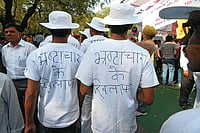Around the marketplace of Chang Gate in Beawar, Rajasthan, are memorials to Gandhi, Ambedkar and Swami Kumaranand, founder of the Communist movement in Rajasthan—and on a stone slab of black granite is a tribute to the Right to Information movement. In a country quick to glorify and iconise individual leaders—quick to reduce the average citizen into awed inaction in front of larger-than-life idols—it’s not often that collectives, issues and principles are given visual space. Maybe they are by definition more abstract. And it’s in speaking of everyday, concrete things that the RTI broke that glass ceiling.
The memorial was put up “by the municipality of Beawar” in 2016—all of two decades after the historic 40-day dharna that marked the launch of the RTI movement in India. One of the speakers that day said Beawar is known as the “til patti sheher” (the city known for its sesame sweet), but would like to be acknowledged as the RTI city! It’s only appropriate, for it had hosted and nurtured one of independent India’s landmark people’s movements for a democratic ideal. Also fitting that a book written as a tribute to the ordinary people who struggled for long to build this movement was launched from the same spot on April 6, 2018. That’s 22 years since the dharna began.
If the movement could be characterised in any way, it’s the central presence of the ordinary Indian, and this book was meant as a testament of that live, ongoing truth: the richness of their contribution. The product of that effort is The RTI Story: Power to the People—put together by a small editorial group, and told from the perspective of the Mazdoor Kisan Shakti Sanghathan (MKSS), with me as the sutradhar. It was conceived as a chronicle of democratic determination, where power is defined not by the elite in the corridors of Lutyens’ Delhi but by an invisible India. Democratic justice is not a philanthropic gift but a collective entitlement to be wrested by the people—the real sutradhars of the RTI narrative.
There’s a way in which the power of the truthful word can move people and things—and change reality. The idea of RTI had been growing, in fact, for nearly a decade before that April day in Beawar. Right from its first battle to access land rights in Sohangarh, in 1987, the MKSS had begun to see the crucial importance of transparency as a tool to fight corruption.

























